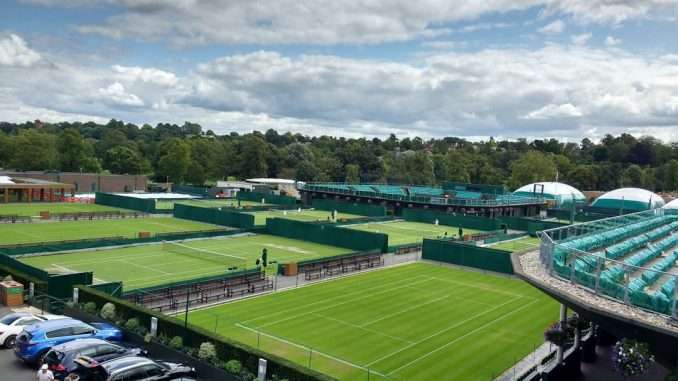
The All England Lawn Tennis Club (AELTC) has embarked on an ambitious journey, one that intertwines the future of professional tennis with the well-being of the local community in a £200 million expansion of the iconic Wimbledon grounds. This comprehensive project endeavours to not only enhance the stature of the world’s most esteemed tennis tournament but also seeks to reimagine the adjacent landscape as a paragon of parkland accessibility, economic vitality, and environmental mindfulness.
Read more about sustainable development.
At the heart of the AELTC’s expansion is the proposition to cultivate an additional four acres of public parkland, providing an invitation to the community to partake in 27 acres of revitalised green space. This initiative aims to repurpose a formerly private golf course into a flourishing, green haven that welcomes both locals and visitors alike. Incorporating a new wildflower meadow and planning for a diverse array of community events, the project is poised to establish this area as a lively centre of recreation and enjoyment that extends well beyond the celebrated two weeks of tennis.
In an effort to preserve Wimbledon’s pre-eminence in the global tennis arena, the development blueprint includes the construction of a new 8,000-seat Parkland Show Court and 38 additional grass courts. These state-of-the-art facilities are poised to comply with the highest echelons of the sport, ensuring that Wimbledon remains a magnet for premier talent and continues to be regarded as the zenith of the tennis season.
The AELTC’s commitment to environmental stewardship is manifest in their pledge to undertake desilting works on Wimbledon Park Lake and the introduction of 1,500 new trees. These initiatives are intended to enhance local biodiversity and create a space that offers enduring benefits to the community and wildlife throughout the year.
Nevertheless, the journey towards these ambitious goals has not been without its hurdles. The initial refusal of the redevelopment proposal for Wimbledon Park Golf Club by the Wandsworth Borough Council resonated with the community, igniting anxieties over the potential loss of valued green space within the capital. This led to a petition, ‘Save Wimbledon Park’, which swiftly garnered over 18,000 signatures, signalling the strength of local feeling.
In response to the apprehensions raised, the AELTC engaged in a comprehensive public consultation process, reaching over 7,000 individuals via tours and informational events. This endeavour underscored the club’s resolve to ensure that the expansion reflects the interests and allays the concerns of those it will affect the most.
Despite receiving a mixed reception, the AELTC remains unyielding, emphasising the dual benefit of the expansion: reinforcing Wimbledon’s status as a premier sporting event while simultaneously enriching the local community. The chair of the AELTC, who is also a local resident, perceives the project as a “double win,” capturing the opportunity to establish a harmonious balance between elite sporting facilities and public leisure spaces.
The financial implications are significant, with the project projected to channel over £300 million into the local economy and create more than 250 new jobs. This economic boon is expected to ripple throughout Wimbledon, offering employment opportunities both during the construction phase and beyond, as the new facilities become fully operational.
With the Greater London Authority (GLA) initiating a 30-day consultation period, residents are encouraged to engage in this crucial dialogue. This reflective stage is critical, acting as a bridge between the project’s ambitious aims and the concrete concerns of the community.
The AELTC’s vision for Wimbledon’s future reflects the evolving role of sports venues within society. These complexes are transitioning from being perceived as exclusive enclaves for sporting elite to becoming essential elements of the public domain, offering a multitude of environmental, economic, and social advantages.
As the AELTC navigates the challenges that lie ahead, it has the opportunity to lead the way in establishing a new benchmark for the harmonious integration of major sporting events and their host environments. By carefully considering resident feedback and incorporating it into their development strategies, the club can set the Wimbledon Park Project as an exemplar for similar ventures worldwide.
As London stands on the cusp of this transformative project, the international community looks on with keen interest. The pressing question remains as to whether Wimbledon’s expansion will be realised as an innovative amalgamation of global sporting distinction and local community spirit. While the full impact of this endeavour will unfold over time, the AELTC’s aim is unequivocally defined: to forge a legacy that transcends the achievements on the tennis courts, striving to engender a profound and lasting positive effect for all stakeholders.


Be the first to comment